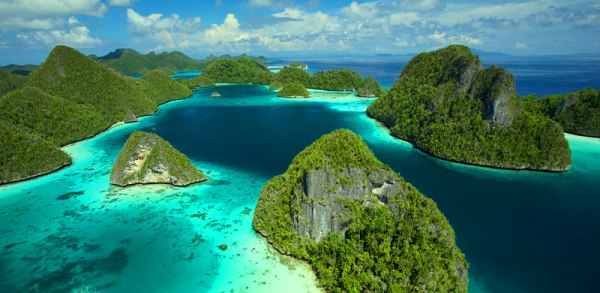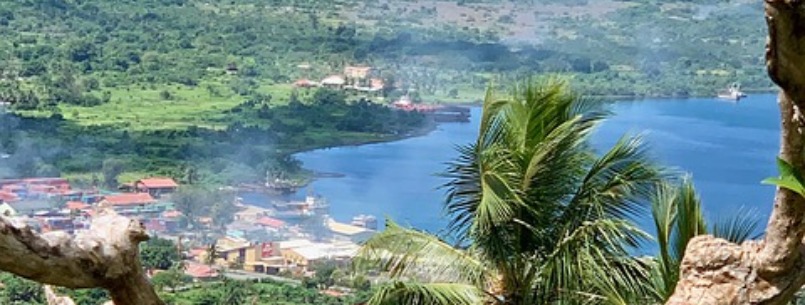2024 Papua New Guinea Visitors Guide
Papua New Guinea is a land of incredible beauty, with awesome mountains, plunging gorges and rushing rivers. It is part of the largest non-continental island in the Pacific and is in the middle of a long chain of islands which form part of a great arc of mountains stretching from the Asian mainland through Indonesia and into the South Pacific. It has more than 600 islands and is south of the equator, some 150 kilometers north of Australia.
CAPITAL AND MAJOR CENTERS
Port Moresby is the capital and was named after Admiral Sir Fairfax Moresby. Other major centers are Lae, the second-largest city situated at the mouth of the Markham River; Madang, consisting of reef-fringed low lands backed by some of the most rugged mountains in Papua New Guinea; the Eastern Highlands with its capital Goroka; Western Highlands Province with Mt. Hagen as the capital, (Rabaul, prior to recent volcanic eruptions was the center of tourism and is now being rebuilt); and the Sepik River running 1,126 kilometres from source to sea, one of the world’s largest waterways.

THE PEOPLE
Locals are predominantly Melanesians and Papuan with some Negrito, Micronesians, and Polynesians. More than 800 indigenous languages are spoken throughout Papua New Guinea. Melanesian Pidgin and Hiri Motu are the two widely used, but English is the official language in education, business, and government circles.
HISTORY
First settled more than 30,000 years ago, the first recorded sighting by Europeans was in 1512 by two Portuguese explorers. Dutch explorers followed and named it New Guinea because of similarities to Africa. Interaction between regions has been largely restricted due to the topography of the land and the diversity of the languages. Apart from areas where missionaries and traders exerted their influence, many tiny, independent villages account for most of the traditions and cultural heritage which is preserved today. The country was divided between three nations, the Dutch, the Germans and the British towards the end of the last century.
In 1905, Australia took over the British sector naming it “the territory of Papua” and then captured the German sector during WWI. The country became fully independent in 1975 and is now a member of the British Commonwealth with strong ties to Australia.
A Masters in Project Management Online is a degree that can be completed while you continue to work, and the skills acquired can be carried over into your existing role within your organization.

NATURE
The animal life is as varied as its vegetation. High mountains and wide lowlands provide a favorable environment for many kinds of animals. Sandy wallabies are found in the savanna grasslands of the south coast, and shy forest wallabies live in the forests. There are also slow-moving cuscuses, two kinds of echidnas, seven birdwing butterflies and bats, bandicoots, possums, gliders and tree kangaroos.
Also, more than 700 bird species including 38 of the world’s 43 species of the spectacular Bird of Paradise, New Guinea eagles, and goura pigeons are to be found. There are also thousands of insects, plus more orchid species than any country in the world.
THE SIGHTS
The infamous Kokoda Trail is within striking distance of Port Moresby which sprawls along the coastal bays and back into the hills. The central province is home to the Variarata National Park, a spectacular mountain region. In the delta land of the Papuan Gulf, there is a maze of flooded waterways, and villages built high on stilts above the muddy river banks. Daru is the main town of Western Province. Situated on a small island of the same name just off the coast while Bensbach Wildlife Lodge, a few kilometers from the Irian Jaya Border is well worth a visit. In the northern province is Mount Lamington, an active volcano which is a favorite climb for visiting bushwalkers.
The Milne Bay islands are 160 in all and Moresby Province is a huge arc of land on the Huon Gulf which includes a number of volcanic islands between the Huon Peninsula and New Britain.
WHERE TO STAY
Cities and tourist centers have a variety of good quality hotels, as well as guest houses, lodges, and resorts. Some village has basic guest house accommodation for visitors and there is limited camping. Transportation is mostly by air. A good network of roads connects the Northern Zone and the highland region. There are hire and rental cars, local boats and ferries, taxis in larger towns, plus local buses. There is no road link between the northern zone and the capital, Port Moresby because the country is too rugged.
FOOD AND ENTERTAINMENT
Western cuisine is available in hotels, restaurants, guest houses, lodges and village resorts. Port Moresby has many Asian and European restaurants. Major hotels provide their own entertainment. Main activities gold, tennis and squash, fishing, diving, snorkeling, hunting and trekking.
SHOPPING GUIDE
Modern Department complexes rub shoulders with quaint little stores and artifact shops where you can try your hand at gentle bargaining. The village of Aibom, near the Chambri Lakes, is the only place on the Sepik that specializes in pottery
GETTING AROUND
There is also pottery at Yabob and Bilbil Village near Madang and at Milne Bay. Arts and Crafts are as diverse as they are distinctive. Pottery, weapons, carvings and basket work are just a few of the handicrafts sold throughout Papua New Guinea, the world’s largest producer of tribal arts and crafts.
Artifacts and Crafts
There is a fascinating selection of masks, including ancestral and spirit masks which are traditionally the most important. Boys wore them with woven body shrouds which can also be purchased. Decorated boards are popular objects in Papuan Gold culture as are boats, prows, thought to be protective spirits to ward off sickness and evils. Shields come in all shapes and sizes and are made of hide stretched over a framework. Stools, tables, and headdresses are ornate and carry intricate carving while fishing hooks were suspended in the men’s house and represented spirits which helped in fighting, hunting and warding off disease. Skull racks for both enemies and relatives make novel souvenirs and are nicely decorated.
Musical instruments, mostly hand drums, are made from wood with the skin of a snake, lizard or tree kangaroo stretched tightly over the mouth and glued to the rim with tree sap. Finally, jewelry, body ornaments, and accessories are made up of a number of components including pigs’ teeth, shell, orchid stems, dog teeth, seed, snake spine and pigs tusks. The two greatest regions of art are the Sepik River Basin and the Papuan Gulf and the two major craft producing areas are the Huon Peninsula and Milne Bay.
Diving Papua New Guinea
To rate Papua New Guinea as one of the world’s top dive sites is no exaggeration. An enormous variety of land-based and liveaboard expeditions take full advantage of the diversity of dive possibilities available in this secluded frontier. Voted the world’s best liveaboard, the Telita operates out of Alotau to explore Milne Bay Province. The charters cater to advanced divers in a marine wonderland of the extraordinary. From tiny delicate nudibranchs to the world’s biggest fish, the harmless whale shark, divers are assaulted with a stunning array of exotic species. The near-invisible lacy scorpionfish, bizarre ghost pipefish, secretive sea horses and the enigmatic nautilus are all part of the passing parade.
 The Barbarian II operating out of Lae is the vessel to choose if your special interest is the shipwrecks from WW2. Skipper Rod Pearce is accredited with discovering the intact B17 bomber “Blackjack” and the Dutch cargo ship Jacob. Along with a host of other ships and airplane wrecks, Rod can fill any voyage with as many wrecks as the keen diver can handle. With a “no-take” policy, every wreck can be found with intact weapons, cargo and artifacts making every dive a journey into a protected time capsule. Of course, fertile reefs and swarming marine life are all included in every expedition. Jias Aben Resort is a land-based operation just out of Madang taking advantage of the impressive marine life found in the northern waters of the Bismarck Sea. From gentle reef dive filled with colorful fish and swaying garden eels at Eel Garden to the action-packed current dives at Bagabag Island, Jais Aben caters for all levels of experience. Walls and deep passages filled with milling fish can be complemented with dive on the many wrecks found in the region such as the B25 Mitchell Bomber or the 48-meter freighter the Coral Queen.
The Barbarian II operating out of Lae is the vessel to choose if your special interest is the shipwrecks from WW2. Skipper Rod Pearce is accredited with discovering the intact B17 bomber “Blackjack” and the Dutch cargo ship Jacob. Along with a host of other ships and airplane wrecks, Rod can fill any voyage with as many wrecks as the keen diver can handle. With a “no-take” policy, every wreck can be found with intact weapons, cargo and artifacts making every dive a journey into a protected time capsule. Of course, fertile reefs and swarming marine life are all included in every expedition. Jias Aben Resort is a land-based operation just out of Madang taking advantage of the impressive marine life found in the northern waters of the Bismarck Sea. From gentle reef dive filled with colorful fish and swaying garden eels at Eel Garden to the action-packed current dives at Bagabag Island, Jais Aben caters for all levels of experience. Walls and deep passages filled with milling fish can be complemented with dive on the many wrecks found in the region such as the B25 Mitchell Bomber or the 48-meter freighter the Coral Queen.
The eastern islands of New Britain and New Ireland have their own wonders to explore including the incomparable hard coral reefs and the spectacular marine life of Kimbe Bay.
Rabaul
Rabaul is famous for its volcanos and shipwrecks. The Michelan operates out of Rabaul to explore the wrecks in Rabaul harbor and the reefs around Duke of York Islands. Wrecks such as the mini Japanese submarines as well as remote reefs are explored on each trip. Swirling schools of barracuda and trevally are found as well as the beautiful silvertip shark, coaxed in with baits to within camera range. Walls or gorgonian sea fans along with deep spongy beds complement the shallow coral gardens with schools of speckled Eagle Rays. Shore-based operations can be found at Malagan Beach Resort for those who want to compliment the superb diving with shore-based activities. With such a rich intensity of color and beauty, Papua New Guinea justifiably holds an international reputation for gourmet diving.

Raja Ampat – Four Kings Archipelago
Located off the northwest tip of Bird’s Head Peninsula on the island of New Guinea, in Indonesia’s West Papua province, Raja Ampat, or the Four Kings, is an archipelago comprising over 1,500 small islands, cays and shoals surrounding the four main islands of Misool, Salawati, Batanta and Waigeo, and the smaller island of Kofiau. It encompasses more than 40,000 km² of land and sea, which also contains Cenderawasih Bay, the largest marine national park in Indonesia. It is a part of the newly named West Papua (province) of Indonesia which was formerly Irian Jaya. The islands are the most northern pieces of land in the Australian continent. According to Conservation International, marine surveys suggest that the marine life diversity in the Raja Ampat area is the highest recorded on Earth.
